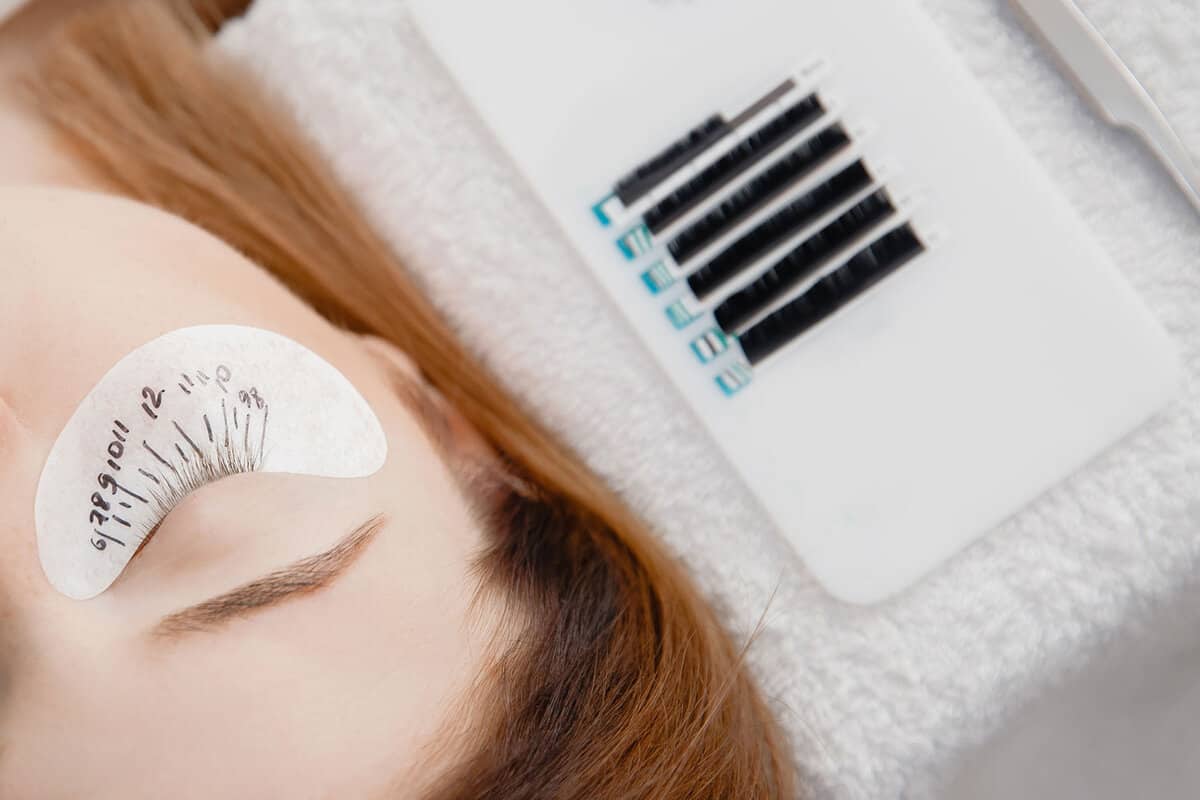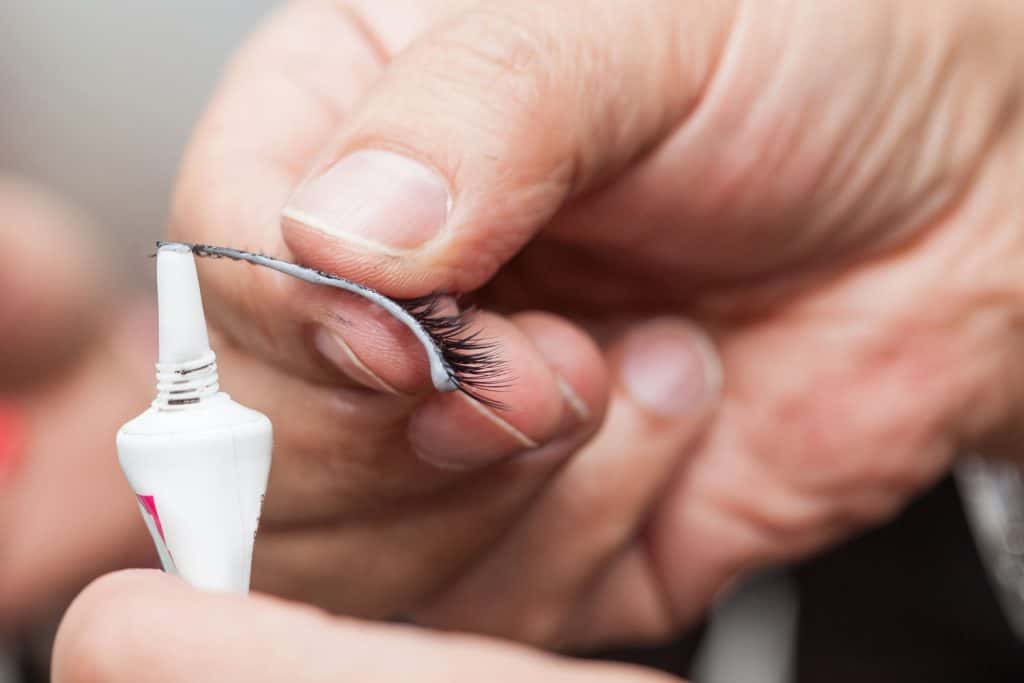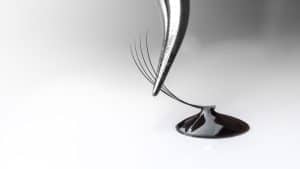Are you curious about what type of glue lash techs use to keep your lash extensions in place?
The most commonly used type of lash adhesive among professionals is ethyl cyanoacrylate glue.

This article may include affiliate links and elements that were carefully created by our team using advanced ai to help you envision the best style advice.
Whether you're a client or an artist, it's important to understand the different types of lash adhesives available and what makes them effective.
Let's start!
What Type of Glue Do Lash Techs Typically Use?
Lash techs use a variety of glues, but most contain ethyl cyanoacrylate (more on this later).
These adhesives dry quickly and can hold extension lashes in place for a long period, making them a go-to choice for most lash techs.

It's widely available in clear and black varieties, making finding the perfect match for your lashes easy.
Another popular type of glue among lash techs is rubber-based glue. It features a flexible hold, which allows the extensions to move more naturally with your natural lashes.
Typically, these adhesive formulations have an average lifespan of approximately four weeks, providing a reliable and versatile option for lash applications.
5 Best Eyelash Glue Brands Used by Lash Techs
Here, we'll discuss five popular products commonly used by Lash Techs and evaluate their ingredients and the pros and cons according to users.
Livbay Original
Livbay Original adhesive is formulated with ethyl cyanoacrylate, poly (methyl methacrylate), hydroquinone, and carbon black.
It's favored for its remarkable retention, lasting up to 5 weeks. It suits experienced and beginner Lash Artists because of its thin consistency and low fume emissions.
It's best to apply in a controlled environment with temperatures between 67 to 73 degrees Fahrenheit and 45 to 65% humidity for optimal results.
Pros:
- Quick drying, reducing application time.
- Strong bond for longer-lasting extensions.
- Suitable for both experienced and beginner Lash Artists.
- Low fume emissions.
Cons:
- Quick-drying nature can be challenging for beginners.
- Potential for overuse due to rapid drying.
Lonris Platinum Extra Strong
Lonris Platinum Extra Strong adhesive features ethyl cyanoacrylate and PMMA in its composition.
It stands out for its rapid drying time of 0.5 - 1 second.
Users have praised its impressive bonding power and ability to maintain extensions for 8-9 weeks, though its rapid drying nature demands precise application.
Pros:
- Exceptionally quick drying time.
- Impressive bonding power.
- Extended retention of 8-9 weeks
- Suitable for various lash extension techniques.
Cons:
- Demands precise and quick application.
- Can be pricier compared to standard adhesives.
Holy Grail
Holy Grail adhesive is formulated with acrylates/ethylhexyl acrylate copolymer and water.
It boasts a fast drying time and low fume emissions, making it suitable for classic and volume eyelash extensions.
Users have reported good retention with this adhesive, which can be applied in a wide range of humidity levels, spanning from 15% to 70%.
Notably, it is latex-free and offers a reliable hold for 6-8 weeks.
Pros:
- Fast drying time and low fume emissions.
- Good retention for 6-8 weeks.
- Latex-free and versatile for different humidity levels.
- Suitable for classic and volume eyelash extensions.
Cons:
- Some users may still experience mild irritation.
- Pricing varies by brand and can be on the higher side.
- Availability may vary.
Lilly Lashes Clear Brush-On Lash Adhesive
Lilly Lashes Clear Brush-On Lash Adhesive contains acrylates/ethylhexyl acrylate copolymer, aqua, ethylhexylglycerin, tocopherol, and phenoxyethanol.
Users have praised its strong bond, comfortable wear, and ease of application with its brush-on design.
However, some have noted that it tends to dry out quickly, potentially leading to stickiness issues.
Pros:
- Strong bond and comfortable wear.
- Easy application with a brush.
- Dries clear for a natural look.
Cons:
- Tendency to dry out quickly.
- Require more frequent touch-ups.
- Some users find it less long-lasting than other adhesives.
Ardell Lashgrip Strip False Lash Adhesive
Ardell Lashgrip Strip False Lash Adhesive comprises water, rubber latex, cellulose gum, sodium dodecylbenzene sulfonate, and ammonium hydroxide, among other ingredients.
Reviews on this product vary, with some users reporting satisfactory results and others expressing frustration over its extended drying time.
It may not be suitable for those who require a quick-drying adhesive, as it has been criticized for remaining in a liquid state for an extended period.
Pros:
- Widely available and affordable.
- Suitable for strip lashes and occasional use.
- Easy to remove with water.
Cons:
- May not provide a quick-drying solution for individual lash extensions.
- Not suitable for those with allergies due to rubber latex content.
Why Is the Choice of Glue So Important for Lash Extensions?
Not all glues are created equal, and each has unique properties that can affect the final outcome of your lash extensions.
The wrong glue can cause many problems, including poor retention, irritation, and even allergies.
Poor retention can lead to lashes falling out prematurely, which can be frustrating for both clients and lash techs.
The right glue, on the other hand, can make all the difference in achieving a beautiful set of lashes that last for weeks.
A high-quality glue can improve retention, reduce irritation, and ultimately lead to happier clients.
It's important to note that not all glues work for everyone. Factors such as humidity, temperature, and the client's natural lashes can all affect how well a glue performs.
That's why it's crucial to experiment with different glues and find the one that works best!
Continue reading: Can You Use Glue On Magnetic Lashes?
What Should You Know About the Ingredients in Lash Glue?
As mentioned earlier, most lash glues contain cyanoacrylate, a quick-setting adhesive that is the main ingredient in superglue.
The ingredient is what allows lash glue to bond quickly to your natural lashes and hold the extensions in place.
However, cyanoacrylate can also cause irritation and allergic reactions in some people.
If you have sensitive eyes or a history of allergic reactions, choosing a lash glue specifically formulated for sensitive eyes is important.
Additionally, lash glue may contain other ingredients like hydroquinone, which helps keep the glue in a liquid state, and carbon black, which gives the glue its black color.
Some lash glues may also contain formaldehyde, a preservative that can cause irritation and allergic reactions in some people.
Eyelash Glue Buzzwords
When it comes to eyelash glue, there are a few buzzwords that you'll want to keep in mind as you search for the perfect adhesive.
Here are some of the most important terms to know:
Formaldehyde
Formaldehyde is used to produce cyanoacrylate adhesive, but it dissipates during manufacturing, leaving no trace in the final product.
Although a minimal amount is released as a natural byproduct during the adhesive's curing process, it's not at concerning levels.
It's good practice for lash artists to wear protective gear, like the Lace Carbon Filter Mask, and maintain well-ventilated workspaces to filter out VOCs.
It's all about creating a safe environment.
And for clients, a piece of advice: always communicate with your lash artist. Inquire about the adhesive they're using and gauge their understanding of it.
Remember, it's your face's delicate area in question. So, it is crucial to ensure that the person handling the chemicals knows their stuff.
Medical Grade
The term "medical-grade" in the context of cyanoacrylate adhesive can be misleading, as there's no official standard for this label.
Eyelash glues, especially those containing cyanoacrylates like Ethyl and Methyl Cyanoacrylate, are produced under strict conditions.
Though cyanoacrylates can cause skin adhesion or irritation, they possess medical benefits when used correctly.
For instance, in 2002, the US FDA approved Indermil®, a medical device for the closure of skin wounds that contains Ethyl 2-cyanoacrylate, confirming it doesn't sensitize the skin.
However, just because a product claims "medical grade" doesn't guarantee higher quality or safety.
Lash techs and aspiring DIY artists should use these adhesives carefully, ensuring well-ventilated spaces and wearing protective gear.
On the other hand, clients are encouraged to consult professionals and conduct thorough research before undergoing treatment.
Related article: How To Know If Lash Glue Is Bad?
Retention
Retention refers to how long the eyelash extensions will stay in place.
A good adhesive should provide a robust, long-lasting hold without damaging the natural lashes. Look for a bond with a retention time of at least four weeks.
Are There Natural or Hypoallergenic Alternatives Available?
Natural and hypoallergenic alternatives are available if you have sensitive skin or are concerned about the harsh chemicals found in traditional lash adhesives.
These alternatives are perfect for anyone who wants to avoid irritation or allergic reactions.
Natural Lash Adhesive
One option is using a natural lash adhesive made from water, beeswax, and plant-based resins.
These adhesives are gentle on the skin and eyes and are perfect for clients who want a more natural look.
However, they may not be as strong as traditional adhesives and may not hold up as well during physical activity.
Get the KISS Sister Nature Glue on Amazon.
Hypoallergenic Lash Adhesive
Another alternative is to use a hypoallergenic lash adhesive.
These adhesives are formulated to be less irritating to the skin and eyes and are perfect for clients who have had allergic reactions to traditional bonds.
They are also great for clients with sensitive skin or eyes.
Get this Companion Hypoallergenic Eyelash Glue on Amazon.
Adhesive Issues That Can Lead to Bad Retention
Here are some common adhesive issues that can lead to bad retention:
Inappropriate Adhesive Consistency
Again, not all adhesives are created equal. Some are thicker, while others have a more watery consistency.
It's crucial to choose the right consistency based on the lash artist's speed and the client's needs.
Incorrect Adhesive Curing
The conditions under which the adhesive cures matter. Humidity and temperature can affect the adhesive's performance.
If the room is too humid or too dry, the glue might not bond correctly.
Old or Expired Adhesive
Just like any other product, lash adhesives have a shelf life.
Using an old or expired adhesive can result in weak bonding, making extensions fall out sooner.
Not Enough Adhesive
If a lash artist uses too little adhesive, the bond between the natural lash and the extension might not be strong enough, leading to poor retention.
Overuse of Adhesive
On the flip side, using too much adhesive can cause clumping. This not only looks unappealing but can also cause lashes to stick together, resulting in lash loss.
Also read: How To Get Eyelash Glue Off: Tips And Tricks
Final Thoughts
Now that you know what glue lash techs use, you can confidently go into your next appointment or DIY session knowing what to expect.
Remember that different lash glues come with varying strengths and drying times.
To ensure the best results, always maintain open communication with your lash tech or fellow DIY enthusiasts.
Whether you're a seasoned lash tech, a newcomer to the field, or someone attempting DIY lash extensions, safety should always be your top priority.
So, regardless of the adhesive you select, be sure to adhere to the correct application techniques.
Lash extensions can be a fun and glamorous addition to your beauty routine, but it's important to use them responsibly and with care.








![Scientist holding Cyanoacrylate glue, Is There An Eyelash Glue Without Cyanoacrylate? [A Guide to Finding Safe Alternatives] - 1600x900](https://stylecheer.com/wp-content/uploads/2023/09/shutterstock_2238414685-300x169.jpg)
![Applying lash glue onto fake eyelashes, Why Is My Lash Glue Not Sticking? [Common Reasons and Solutions] - 1600x900](https://stylecheer.com/wp-content/uploads/2023/09/shutterstock_1059533828-300x169.jpg)
